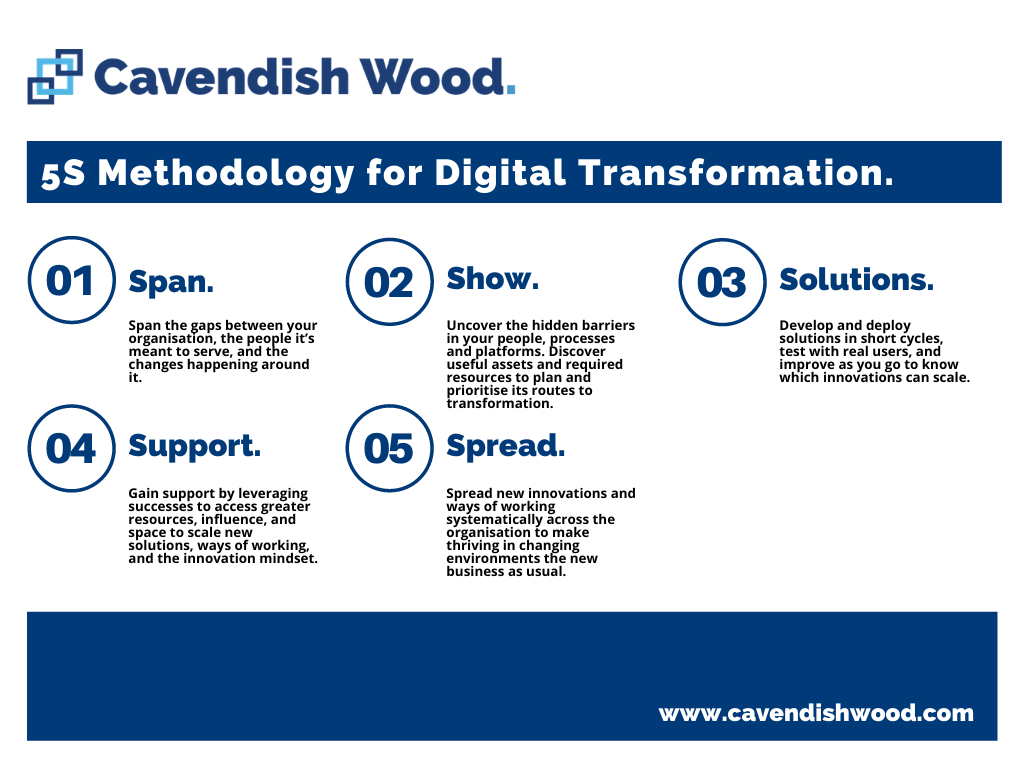
Digital transformation is no longer an option but necessary for businesses across all sectors. Companies are under constant pressure to innovate, meet customer expectations, and stay ahead of the competition, all while managing budget constraints.
To effectively leverage digital capabilities in the private sector, CEOs, Senior Business Leaders, CIOs and CTOs must focus on:
- Modernising services to meet current market demands.
- Cultivating a culture that supports sustainable digital innovation.
- Identifying and realising significant cost savings across the board.
The 5S Methodology for Digital Transformation.
At Cavendish Wood, we've developed a unique approach called "The 5S Methodology for Digital Transformation." This methodology has been honed through our extensive experience working with various industries. Over the coming weeks, we'll delve into each phase of this methodology, outlining key objectives, tools, and techniques to transform your business successfully.

Why Digital Transformation Fails in the Private Sector.
Before diving into the first phase of our 5S Methodology, it's crucial to understand why digital transformations often fail to deliver the expected value. Private sector businesses are complex entities with various departments, each with its own goals and challenges. This complexity, coupled with unique organisational characteristics, makes digital transformation a daunting task.
The Budget Conundrum.
Private sector companies are under constant pressure to show ROI for every investment. Crafting a compelling business case for digital initiatives is challenging due to the fluid nature of digital transformation and the organisational shifts required for meaningful change.
Culture: The Invisible Barrier.
Many companies in the private sector have a traditional organisational culture, with legacy systems and long-standing processes. Often, the IT department is seen as the driver of digital change, which is a flawed approach. IT alone cannot transform the business; it requires a company-wide cultural shift.
The Misconception of Digital Transformation.
The term "digital transformation" is often misunderstood. It's not just about digitising existing processes or adopting new technologies. True digital transformation involves:
- Delivering services that align with customer expectations and the evolving technological landscape.
- Leveraging digital capabilities to drive efficiencies and cost savings.
- Adapting the organisation to stay aligned with customer needs and market trends.
Strategy vs Technology.
Many companies mistake technology adoption for digital transformation. While technology is a crucial enabler, it cannot create new ways of working or improve customer experience without a strategic shift in organisational culture.
Ownership and Accountability.
Digital tools—be it mobile solutions, cloud applications, cybersecurity measures, or data analytics—are often relegated to the IT department. However, these tools should be understood, led, and owned by business leaders across the organisation, as they impact overall efficiency and effectiveness.
Span: The First Phase of Digital Transformation.
Before you embark on your digital transformation journey, it's crucial to understand the first phase of our 5S Methodology: "Span." This phase sets the foundation for a successful transformation by addressing key objectives:
- Spanning internal and external gaps
- Defining a Shared Vision for Transformation
- Appointing a Leadership Team
Spanning the Gaps: External and Internal.
The real solutions to your digital transformation challenges lie outside the confines of your boardroom. This phase is about bridging the external gaps between your organisation and the rapidly evolving market, as well as the internal gaps between different business units, hierarchies, and silos.

How Do These Gaps Form?
Recognising the need for digital transformation is the first sign that gaps have emerged between your internal operations and the external technological landscape. These gaps often arise because technological advancements and customer expectations have outpaced your organisation's ability to adapt.
The Importance of Being Outward-Facing.
Digitally mature organisations focus on delivering solutions based on actual customer needs, not assumptions. They also adopt technologies that are prevalent among their competitors and peers, ensuring they meet or exceed industry standards.
The Challenge of Internal Gaps.
Over time, internal gaps form due to rigid systems of standardisation and hierarchical control. Layers of management and departmental silos exacerbate these gaps, isolating senior leadership from the actual needs and experiences of customers. This often results in a leadership team that struggles with collective decision-making.
How to Span.
To successfully navigate the "Span" phase of digital transformation, you'll need to establish meaningful connections within and outside your organisation. These connections should be with customers, industry peers, strategic partners, and suppliers. Importantly, these relationships must be enduring to prevent the re-emergence of gaps.
Key Outputs from These Connections.
The relationships you build should yield tangible insights into:
- What your customers genuinely need and want
- Whether your current services deliver on their promises
- If your existing services align with customer needs
Questions to Ask.
To get these insights, you'll need to ask:
- What has changed since your current service infrastructure was established?
- What customer experiences are more valuable in both the public and private sectors?
- Which elements of these preferred experiences can you incorporate to improve your services?
The Importance of External Research.
You can't find these answers by merely looking inward. You'll need to step outside your organisation and engage with your external ecosystem. This could involve customer surveys, peer reviews, or supplier interviews, among other methods.
Defining a "Shared Vision for Transformation."
Contrary to popular belief, digital transformation doesn't require a hefty strategy document. Instead, your "Shared Vision for Transformation" should be a living, evolving construct. It should be a concise set of statements that articulate your current position, what needs to change, and why.
Example Statement.
For instance:
Today:
"Our customers interact with multiple departments, each treating them as new customers requiring extensive personal information. This not only creates a poor customer experience but also inefficiencies within our organisation. Additionally, we lack a unified view of customer data, making it difficult to gain actionable insights."
Our Vision for Transformation:
"Customer data should be collected once at the initial point of contact and be accessible across all departments. This will enhance the customer experience while saving time and reducing costs."

Crafting a Shared Vision for Digital Transformation.
No matter where your company currently stands on its digital transformation journey, it's never too late to craft a shared vision. This vision should be a collaborative effort involving key personnel who can drive the initiative forward. To do this effectively, you'll need to identify the internal and external gaps hindering your organisation's ability to adapt to market changes and evolving customer needs. Ask yourself, if your company were founded today, how would it meet these external conditions?
Building Stakeholder Buy-In.
To get everyone on board with this vision, it's crucial to understand the personal goals and motivations of each stakeholder. This includes your senior leadership team, who should help shape and endorse this vision. Their buy-in is essential for the long-term success of your digital transformation efforts.
Navigating Internal Dynamics.
Be mindful that some team members may have their own agendas or be more competitive than others. Their input could be skewed towards benefiting their own departments rather than the organisation as a whole. Encourage a collaborative spirit and the importance of collective success.
Focusing Beyond Technology.
When discussing your vision, avoid getting into the nitty-gritty of technology. Discussions about existing hardware and software can derail the conversation and limit it to incremental changes. Instead, focus on transforming business processes, enhancing customer engagement models, and exploring new avenues for innovation.
Achieving Consensus.
The ultimate goal is to reach a broad agreement on a vision that is both understood and valued by all key players. Achieving this consensus will set your organisation on a path to long-term digital transformation success. Remember, this is a marathon, not a sprint. The process will take time and should be based on delivering clear benefits to all stakeholders, both internal and external.
Setting High Expectations.
Once you have agreement, it's crucial to set high expectations to keep your team continually motivated. This will involve providing the necessary incentives and rewards to encourage the hard work ahead.
Leadership in Digital Transformation.
Assembling the Right Leadership Team.
In any significant venture, especially something as complex and cross-functional as digital transformation, leadership is key. The direction should come from the top, but it's crucial to have a dedicated leadership team to initiate, steer, and ensure the programme's success.
The Digital Portfolio Office (DPO).
To streamline this process, consider establishing a Digital Portfolio Office (DPO). This central hub should include:
- The Sponsor: Typically, the CEO or another executive with the clout and resources to back the transformation effort. They're the ones who can allocate budgets and remove roadblocks.
- Champions: These are senior leaders who are not just open to change but are actively advocating for it. They can offer resources, time, and influence, making their departments ideal testing grounds for new initiatives.
- Change Agent/Programme Director: This individual is the linchpin of the transformation process. They're responsible for driving the agenda and making key decisions. Their professional reputation should be closely tied to the success or failure of the transformation effort.

Qualities of an Effective Change Agent.
While technical skills are beneficial, they're not prerequisites for a successful Change Agent. What's more important is:
- Seniority: Enough influence to effect change at the highest levels of the organisation.
- Inspirational Leadership: The ability to inspire collaboration across departments and beyond traditional silos.
What's Next?
Once you've assembled a leadership team aligned with your Shared Vision for Transformation, you're ready to move on to the next phase of your digital transformation journey. The following step in the 5S Methodology for Digital Transformation—known as "Show"—will involve identifying and prioritising the initial projects to tackle. This phase will help you uncover barriers in your people, processes, and platforms, and identify assets you can leverage for future success. Click here to read "Show" now.

